To keep our families protected, particularly during cold and flu season, we try everything. We wash our hands regularly, give them plenty of vitamin C, and even get flu jabs.
But what about our clothes? Are our clothes harbouring germs that could be making our families ill? And if that is the case, what can we do about it?
Germs can stay on fabrics for quite some time. Viruses and fungi typically die in just a few days, but this can depend on the type. However, things like E. coli and salmonella can stick around on clothes for weeks.
Germs can get on your clothes from just about anywhere too. Using public transport, going to a cafe or restaurant, or even just going to work.
Going anywhere where there are other people can cause germs to cling to your clothing. And, of course, anywhere your family goes.
So, when your kids go to school, they will come home with germs all over their clothing.
However, you are just as likely to put germs on your own clothing as anyone else. Underwear is more likely to have germs on it than outer layers of clothing. So, it is really important that you regularly sanitise your clothes.
How to Sanitise Clothes

To kill bacteria in the washing machine, you can use a higher-temperature wash of at least 60 degrees Celsius. Germs can’t survive these hotter temperatures, so they will be removed and gone forever.
Washing high-risk items
If someone in the home is currently ill, it is best to treat their clothing, bedding and any other fabrics they touch as high-risk.
All this should be washed at higher temperatures (60°C or above) throughout the time they have an illness and for a few days afterwards to ensure that all of the germs are gone.
Take a look at the temperature settings for each piece of clothing to find the highest setting suitable. If you use a higher setting, you could ruin the clothing.
You can also use a sanitising detergent. There are loads on the market now that will kill 99.9% of germs. You can also use bleach during the washing cycle, but this can damage and discolour pieces of clothing.
For a full list of high-risk items, you can check out this NHS article that details how to keep clothing, bedding and other soft furnishings clean while someone in the home is ill.
Do Germs Stay in the Washing Machine?
Germs can also stay in the washing machine. If you usually wash at colder settings of 30 to 40° C, this allows bacteria to survive and even grow in the washing machine.
So, germs could actually be getting on your clothing during the washing cycle.
Running a hot (usually 90°C) maintenance wash once a month and regularly cleaning your washing machine should take care of this.
You can also use a homemade cleaning solution. To do this, add two cups of white vinegar to the detergent dispenser and run a complete washing cycle.
Then run another cycle but this time add half a cup of bicarbonate of soda and use the highest temperature settings; when this cycle is complete, wipe the inside of the drum clean with a microfibre cloth.

In Conclusion
During the cold and flu session, or whenever someone in the home is ill, you may want to increase how much washing you do to avoid soiled clothes being in the house for any longer than they need to be. Make sure you wash on higher temperature settings and clean your washing machine regularly.
The info above will keep your washing machine and your clothes clean and free from germs and may prevent family members from getting sick. For more information about all things washing-related, please explore In The Wash further.

In The Wash is your guide to the best laundry and cleaning products, tips and tricks. Our mission is to solve the UK’s cleaning and laundry dilemmas!






